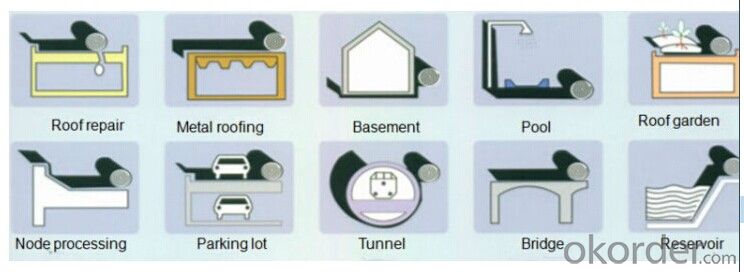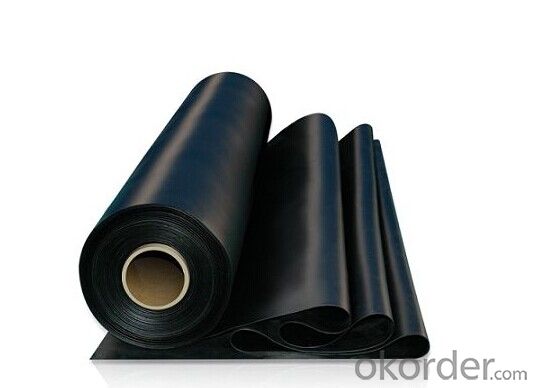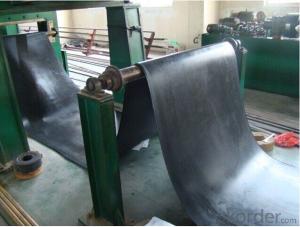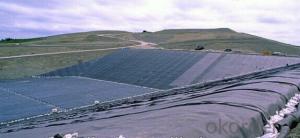EPDM Roof Waterproof Membrane with width 1.0m-4.0m for Roof Use
- Loading Port:
- Qingdao
- Payment Terms:
- TT OR LC
- Min Order Qty:
- 2000 m²
- Supply Capability:
- 300000 m²/month
OKorder Service Pledge
OKorder Financial Service
You Might Also Like
EPDM Waterproof Membrane
Introduction for EPDM Waterproof Membrane
EPDM waterproof membrane is made from ternary ethylene-propylene rubber. With the best performance among high polymer waterproof materials, EPDM is of exceptional elasticity and will not split or crack under normal building movement.
Features for EPDM Waterproof Membrane
1.Excellent anti-aging performance, service life can reach 50 years;
2.High elongation, high tensile strength, heat treatment size change small;
3.Plant root penetration resistance is good
4.Good low temperature flexibility
5.Application is convenient, overlapping is firm and reliable, no environmental pollution;
6. Resistance to chemical corrosion, can be applied to special places;
7.Maintenance is convenient, the cost is low
Application for EPDM Waterproof Membrane
1) Roofs, Basement, Toilet
2) Industrial and civil building waterproofing
3) Geo-synthetic liner for swimming pool, channels, irrigation system
4) Especially suit for projects with high requirements in durability, anti-corrosion and deformation

Specification for EPDM Waterproof Membrane
Item | Thick(mm) | Width | Length(m) | Color |
Spe | 1.0—2.0 | 1.2m/2m/3m/4m | 20 | Black |
Deviation | -1 +15 | --1 | Multicolor |
Technical Sheet for EPDM Waterproof Membrane
EPDM Waterproof Membrane ASTM Standard : D-7465 | ||||
Property | Test Method | Units | Mininum ASTM | |
D-7465 | ||||
Sl | Eng | |||
Specific Gravity | ASTM D-792 | gm/cc | 1.1 | 1.1 |
Unit Weight | ASTM D-751 | kg/m2 | 1.3 | 0.27 |
Thickness Type 1 | ASTM D-412 | mm(in) | 1.02 | 0.04 |
Tensile Strength. Die C | ASTM D-412 | Mpa(psi) | 9 | 1305 |
Ultimate Elongation,Die C | ASTM D-412 | % | 300 | 300 |
Tear Resistance,Die C | ASTM D-624 | Kn/m(lbf/in) | 26.27 | 150 |
Puncture Resistance | ASTM D-4833 | N(lbs) | 133 | 30 |
Shore A Durometer | ASTM D-2240 | 65-10 | 65-10 | |
Ozone Resistance | ASTM D-1149 | No Crack | No Crack | |
Multiaxial Elongation | ASTM D-5617 | % | 100 | 100 |
Heat Aging 28 days at 240 degrees | ASTM D-573 | |||
Tensile Strength, Die C | ASTM D-412 | MPa(psi) | 8.3 | 1205 |
Ultimate elongation, Die C | ASTM D-412 | % | 200 | 200 |
Tear Resistance, Die C | ASTM-624 | Kn/m(lbf/in) | 21.9 | 125 |
Accelerated Aging Xenon Arc | ASTM G-155/G-151 | Pass | Pass | |
Brittleness Point | ASTM D-2137 | -45 °C | -49 °C F | |
Water Absorption | ASTM D-471 | % | +8,-2 | +8,-2 |
Water Vapor Permeability, max | ASTM E-96 | Permils | 2.0 | 2.0 |
Linear Dimensional Change,max | ASTM-D-1204 | % | +/-1.0 | +/-1.0 |
Chronic Toxicity Screening | EPA/600/4-89/001 | Method 1000.0 | Pass | Pass |


FAQ:
Can you produce 4m width?
Yes, no problem for us. We have four bases in China, largest one in this field.
How many quantity in one 20'' container for 1.2mm and 1.5mm?
480rolls, 11520m2 for 1.2mm and 400rolls, 9600m2 for 1.5mm
Can you provide free samples?
Yes, our samples are free, but express fees usually on buyer's account.
- Q:Can a waterproofing membrane be used for a balcony deck?
- Indeed, a balcony deck can be protected by utilizing a waterproofing membrane. It is a highly recommended solution for shielding balcony decks against water damage. The primary purpose of a waterproofing membrane is to establish a barrier that hinders the infiltration of water into the underlying structure. It effectively safeguards the deck from various moisture-related problems such as rot, mold, and deterioration. This membrane is typically applied in either liquid or sheet form, effectively covering the entire surface of the balcony deck to create a seamless and impenetrable layer. Acting as a shield, this membrane ensures that any water coming into contact with the deck is effectively repelled and diverted away. By incorporating a waterproofing membrane, you can successfully prolong the lifespan of your balcony deck and uphold its structural integrity for many years to come.
- Q:Can a waterproofing membrane be applied on top of existing surfaces?
- Indeed, one can indeed apply a waterproofing membrane onto preexisting surfaces. Nevertheless, it is crucial to guarantee that said surface is clean, dry, and in proper condition prior to membrane application. Prior to installation, any cracks, holes, or damages must be repaired. Moreover, the nature of the existing surface may impact the type of waterproofing membrane that can be utilized. It is highly advised to seek guidance from a proficient waterproofing contractor to ascertain the most appropriate membrane for the given surface and circumstances.
- Q:Can a waterproofing membrane be used in conjunction with flooring materials?
- Indeed, flooring materials can be used in conjunction with a waterproofing membrane. It is actually quite common to advise the application of a waterproofing membrane while installing specific types of flooring, particularly in wet spaces such as bathrooms, kitchens, or basements. The waterproofing membrane functions as a shield against moisture, effectively thwarting water penetration that could potentially harm the flooring material or the subfloor. It provides safeguard against leaks, spills, and even excessive moisture in the atmosphere. Through the utilization of a waterproofing membrane, you can guarantee the longevity and sturdiness of your flooring, simultaneously upholding a waterproof and moisture-resistant environment.
- Q:Are waterproofing membranes resistant to root penetration?
- Yes, waterproofing membranes are generally resistant to root penetration. These membranes are specifically designed to prevent water from penetrating through the surface and into the underlying structure. In addition to their water resistance, they also possess qualities that make them resistant to root penetration. This is important in areas where vegetation or trees may be present, as roots have the potential to grow and penetrate through various surfaces, causing damage and compromising the integrity of the waterproofing system. Waterproofing membranes are typically made from materials that are tough and durable, providing a barrier that roots cannot easily penetrate. However, it is important to note that no waterproofing membrane is completely immune to root penetration, as some root systems may be particularly aggressive or invasive. In these cases, additional measures such as root barriers or specialized membranes may be necessary to ensure long-term protection against root penetration.
- Q:Can a waterproofing membrane be used for green roofs?
- Yes, a waterproofing membrane can indeed be used for green roofs. Waterproofing membranes are commonly used as a crucial layer in green roof construction to prevent water leakage and protect the underlying structure. It provides an effective barrier against water infiltration, ensuring the green roof system remains watertight and preserving the integrity of the building.
- Q:Can a waterproofing membrane be used for underground stormwater detention systems?
- Yes, a waterproofing membrane can be used for underground stormwater detention systems. A waterproofing membrane is designed to prevent the penetration of water and can be applied to various surfaces, including concrete, to create a watertight barrier. This makes it an ideal solution for underground stormwater detention systems that require the containment and control of stormwater runoff. The waterproofing membrane ensures that the system remains watertight, preventing any leaks or seepage that could compromise the integrity of the system or contaminate the surrounding soil and groundwater. Additionally, the membrane can also help to protect the concrete structure of the detention system from the corrosive effects of water and other potential contaminants. Therefore, using a waterproofing membrane in underground stormwater detention systems is a reliable and effective way to ensure their functionality and longevity.
- Q:Can waterproofing membranes be used on balconies?
- Yes, waterproofing membranes can be used on balconies. These membranes are designed to provide a protective barrier against moisture, preventing water leaks and damage to the balcony structure. Waterproofing membranes are commonly used in balcony construction and renovation projects to ensure long-lasting water resistance and durability.
- Q:Does a waterproofing membrane require any specific surface preparation?
- Specific surface preparation is necessary prior to the installation of a waterproofing membrane. The quality and condition of the surface play a significant role in determining the success and effectiveness of the membrane. To begin with, the surface must be thoroughly cleaned and devoid of any dirt, debris, oil, grease, or loose particles. This can be accomplished by utilizing a pressure washer, scrub brush, or appropriate cleaning agents. Additionally, any existing coatings or sealants must be eliminated to ensure proper adhesion of the membrane. Furthermore, the surface should be even and smooth. Any uneven areas, cracks, or holes need to be repaired and leveled prior to applying the membrane. This can be achieved by filling the cracks or holes with a suitable filler or patching compound and smoothing it out to establish a uniform surface. Moreover, it is imperative that the surface is completely dry. Moisture can compromise the adhesion and effectiveness of the waterproofing membrane. Therefore, it is essential to ensure the surface is fully dry before commencing the installation. This may involve allowing the surface to air dry or employing appropriate drying methods such as fans or dehumidifiers. In addition to these general surface preparations, specific types of waterproofing membranes may entail additional requirements. For instance, certain membranes may necessitate the application of a primer on the surface before installation. It is crucial to adhere to the manufacturer's instructions and recommendations for the specific membrane being used. Overall, proper surface preparation is vital for the accomplishment of a waterproofing membrane installation. It guarantees optimal adhesion, durability, and performance of the membrane, ultimately preventing water penetration and safeguarding the underlying structure.
- Q:Can waterproofing membranes be used on retaining walls?
- Retaining walls can indeed benefit from the application of waterproofing membranes. It is quite common to utilize these membranes on retaining walls in order to hinder the infiltration of water and safeguard the structure against issues arising from moisture, such as seepage, efflorescence, and cracking. These membranes act as a barrier, effectively preventing water from permeating the retaining wall and causing harm. Typically, they are installed on the exterior side of the retaining wall, providing an added layer of protection against water intrusion. There is a wide range of waterproofing membranes available, including sheet membranes, liquid-applied membranes, and cementitious coatings, allowing for the selection of the most suitable option based on the specific requirements and demands of the retaining wall.
- Q:Can a waterproofing membrane be used for a green roof?
- Yes, a waterproofing membrane can be used for a green roof. This membrane acts as a barrier that prevents water from seeping into the building below and protects the roof from water damage. By installing a waterproofing membrane before adding the green roof components, it ensures that the underlying structure remains dry and protected.
1. Manufacturer Overview |
|
|---|---|
| Location | |
| Year Established | |
| Annual Output Value | |
| Main Markets | |
| Company Certifications | |
2. Manufacturer Certificates |
|
|---|---|
| a) Certification Name | |
| Range | |
| Reference | |
| Validity Period | |
3. Manufacturer Capability |
|
|---|---|
| a)Trade Capacity | |
| Nearest Port | |
| Export Percentage | |
| No.of Employees in Trade Department | |
| Language Spoken: | |
| b)Factory Information | |
| Factory Size: | |
| No. of Production Lines | |
| Contract Manufacturing | |
| Product Price Range | |
Send your message to us
EPDM Roof Waterproof Membrane with width 1.0m-4.0m for Roof Use
- Loading Port:
- Qingdao
- Payment Terms:
- TT OR LC
- Min Order Qty:
- 2000 m²
- Supply Capability:
- 300000 m²/month
OKorder Service Pledge
OKorder Financial Service
Similar products
New products
Hot products
Related keywords




























